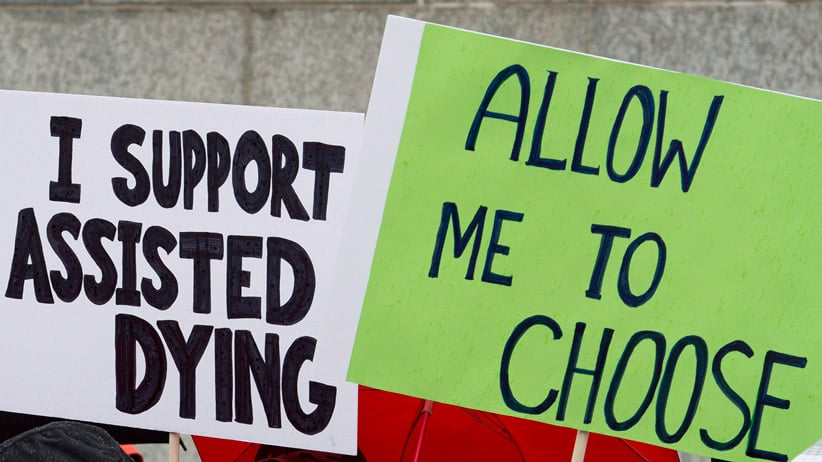What comes after the Supreme Court’s assisted suicide ruling?
Editorial: The Supreme Court has ruled it is not criminal to assist suicide. Now what? Anarchy, perhaps. Certainly the battles are not over.
Supporters rally outside the Supreme Court of Canada on the first day of hearings into whether Canadians have the right to seek help to end their own lives Wednesday October 15, 2014 in Ottawa. Adrian Wyld/CP
Share

Let’s try admitting it to each other: it is not easy to say whether the Supreme Court of Canada’s ruling wiping out Criminal Code provisions forbidding assisted suicide will turn out to be the right one, outcome-wise. The court, after all, did not prescribe an ultimate outcome. It struck down an absolute rule it found to be “overbroad” in its effects. Legislators, it said unanimously, need to design a regime for doctor-assisted death that allows “competent adults . . . suffering intolerably as a result of a grievous and irremediable medical condition” to have access to it.
But the justices did not say much about what principles the new rules need to follow, assuming that there must be some limits on access to active medically administered suicide. Some desirable restrictions are implied in words like “competent” and “adult” and “intolerably” and “grievous,” but the court didn’t go into any detail about the meanings of those terms. Their formulation sounds good, and may be the right answer to a big question. But even if legislators are capable of getting off their duffs and designing a system of good death for the ill, one can see an endless network of litigation over particular sub-questions and criteria. (The Supreme Court’s decisions often have a way of creating that effect.) Who counts as an adult? Does “remediable” mean “curable”? Must the suffering be physical?
The assisted suicide decision, Carter v. Canada, seems to have strong public support. The court has backed a majority of Canadians who feel that an absolute criminal prohibition on assisted suicide is inappropriate, and it has rejected a significant minority who believe that an absolute prohibition helps underline the principle of the sanctity of life and protecting the vulnerable.
The problem is that the effort to design assisted-suicide laws is likely to break up that friendly majority. Someone will have to design ugly bureaucratic procedures for weighing competency and seriousness of suffering. Those will be seen to fail in some cases, and they will be constantly challenged. Or there will simply be a void in the law, leaving the possibility of a circus-like spectacle of people seeking assisted suicide for reasons most of us find preposterous.
 RELATED:
RELATED:
On assisted suicide, the Supreme Court confronts Parliament’s cowardice
The Interview: CMA president Dr. Chris Simpson on assisted dying
Geddes: Top court allows ‘physician-assisted death’
You should not have to win a lottery to die in dignity
Moreover, this court had to trample precedent a little roughly to reach the finding in Carter, which unabashedly contradicts their earlier doctrine in Rodriguez v. B.C. (1993). Paradoxically, that makes us less sure what views future courts might take of the tricky components of the “competent adults suffering intolerably” formula. Supporters of the court’s broad stroke have been quick to make remarks like, “Hey, it’s not as though the court is insisting on Flintstones-shaped sodium pentothal tablets for kiddies.” But the Carter decision, by design, evades the question of how such things—or others that might be more realistically imagined—might be constitutionally proscribable. The Supreme Court thought the Criminal Code’s “blanket ban” on assisted suicide was fine, until it didn’t.
The fact is that none of us can be as confident as we would like in formulating rules for assisted suicide. It is easy to say we want the option of dying with dignity, or that we want it for older loved ones, but there is a lot of hidden complexity in that concept. “Dignity” appears to involve, in practice, a complex bundle of state permissions, reassuring tidiness, and the learned comforts of a doctor’s presence. We think a scheduled death that looks like sleep is more “dignified.”
If there were actually a reliable Flintstones vitamin for death, something one could slip under one’s tongue even in a state of profound disability, there would never be lawsuits like Carter v. Canada. Death remains intractably difficult, both to think about and to go through with, even if it is “assisted” or presided over. Dying-with-dignity advocacy often seems to be not so much about unconditional personal autonomy as about trying to fight—or deny?—the human condition: weakness, decrepitude, extinction.
It is, to be sure, the whole purpose of medicine to ameliorate those features of the human condition. But it is not clear that doctors will want to be left alone to set the rules for assisted suicide. Nor is it clear that they ought to be allowed to, although that is how Canada ended up dealing with abortion after a Supreme Court decision nullified a different part of the criminal law. If you think our current abortion anarchy is an optimum outcome of a passive-aggressive political negotiation between the courts and the legislature, maybe you can afford to be content with the Carter decision. If you are vaguely embarrassed by it—and many people who are otherwise pro-choice are embarrassed—then you might be concerned that the assisted-suicide fight is just beginning.